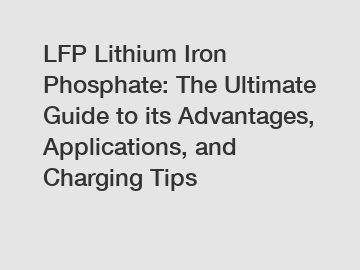LFP Lithium Iron Phosphate: The Ultimate Guide to its Advantages, Applications, and Charging Tips
LFP Lithium Iron Phosphate: The Ultimate Guide to its Advantages, Applications, and Charging Tips.
Lithium iron phosphate (LFP) batteries have gained significant attention in recent years due to their numerous advantages over other types of batteries. In this comprehensive guide, we will delve into the advantages, applications, and charging tips of LFP batteries, shedding light on why they have become a popular choice in various industries.
Advantages of LFP Batteries.

LFP batteries offer several key advantages that make them stand out in the energy storage industry. Firstly, they have a high thermal and chemical stability, which ensures their safety even in extreme conditions. Unlike other lithium-ion batteries, LFP batteries have a reduced risk of thermal runaway or explosion, making them ideal for applications where safety is paramount.
Secondly, LFP batteries have a longer lifespan compared to other lithium-ion batteries. With a typical cycle life of 2000-5000 cycles, LFP batteries can last significantly longer before reaching their end of life. This extended lifespan not only reduces the need for frequent battery replacements but also contributes to lower maintenance costs.
Another advantage of LFP batteries is their high energy density. With a theoretical energy density of 170 Wh/kg, LFP batteries can store more energy in a smaller and lighter form factor. This makes them ideal for applications where weight and space constraints are a concern, such as electric vehicles and portable electronics.
Applications of LFP Batteries.
Due to their unique advantages, LFP batteries find applications in various industries. One notable sector is the electric vehicle industry, where LFP batteries are preferred for their safety and longer lifespan. Electric vehicles powered by LFP batteries can run longer distances and require fewer battery replacements, contributing to a more sustainable and cost-effective transportation solution.
LFP batteries are also widely used in the renewable energy sector. As renewable energy sources like solar and wind become increasingly popular, LFP batteries serve as an efficient and reliable energy storage solution. They can store excess energy generated during peak production periods and release it when demand is high, ensuring a stable and continuous power supply.
Charging Tips for LFP Batteries.
To maximize the lifespan and performance of LFP batteries, proper charging techniques should be followed. Unlike other lithium-ion batteries, LFP batteries do not require a full charge or discharge to maintain their health. In fact, keeping LFP batteries at a partial state of charge between 20% and 80% is recommended.
Additionally, it is important to use chargers specifically designed for LFP batteries. These chargers typically have a lower voltage and current limit compared to chargers for other battery chemistries. Using the wrong charger can lead to overcharging or undercharging, which can negatively impact the battery's lifespan and performance.
In conclusion, LFP batteries offer significant advantages in terms of safety, lifespan, and energy density. Their applications span across industries, including electric vehicles and renewable energy. By understanding the charging tips for LFP batteries, users can ensure optimal performance and longevity. With their unique advantages and growing popularity, LFP batteries are poised to revolutionize the energy storage landscape and contribute to a more sustainable future.
For more information, please visit life phosphate battery, lithium forklift battery companies, li fe po4 cells.

Comments
0